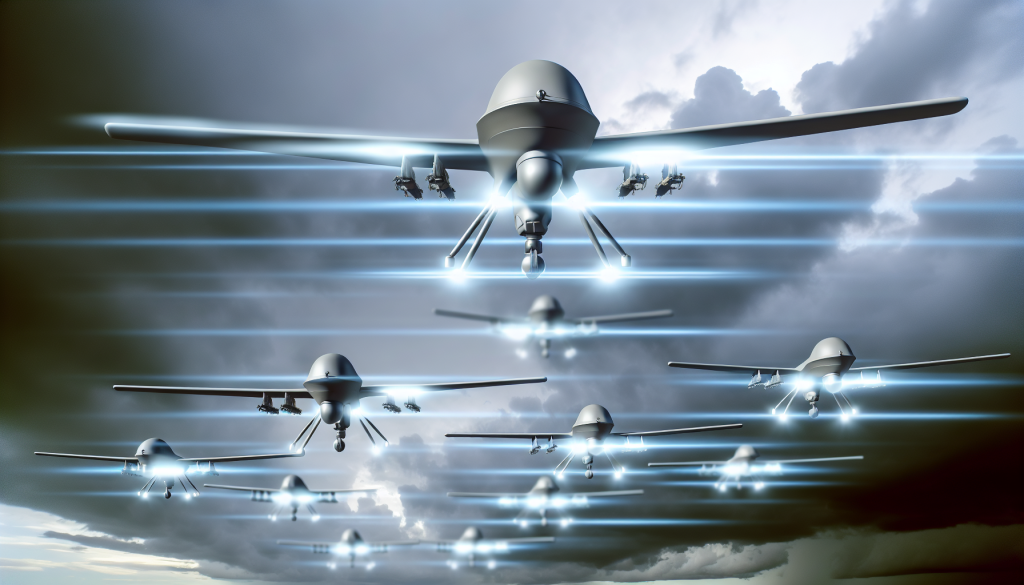The Future of Warfare: The Rise of Drone Swarms
The use of drones in military conflicts has reached a pivotal stage, particularly highlighted in recent conflicts in Ukraine and the Middle East. The emergence of cheap, effective drone technology has led to a frantic race among military powers to enhance uncrewed vehicles that can coordinate autonomously on the battlefield. This new generation of drones, often dubbed “swarms,” could fundamentally alter the nature of warfare.
Intelligent Swarms: A New Era of Warfare
At the forefront of this drone revolution lies the potential for intelligent swarms—drones that not only operate independently but also collaborate seamlessly to achieve complex tactical objectives. According to a U.S. government report, these swarms could execute missions with minimal human intervention, significantly enhancing operational efficiency on the battlefield. Samuel Bendett, an adviser to the Center for Naval Analysis, describes this capability as nothing short of a “holy grail” for military strategists.
Ethical Dilemmas in Autonomous Warfare
However, this technological advancement is accompanied by ethical complexities that cannot be overlooked. The integration of artificial intelligence into weapons systems raises significant questions about accountability and human oversight in combat scenarios. For decades, Pentagon officials have assured that humans would remain “in the loop” for critical killing decisions. Yet, recent updates to Defense Department policies hint at a shift towards greater autonomy, leaving many experts concerned about the implications of fully autonomous weapons.
Duane T. Davis, a senior lecturer at the Naval Postgraduate School, emphasizes the stringent approval required for testing fully autonomous systems. But the door is ajar for the possibility of fully autonomous weapons, spurred by fears of adversarial nations leveraging their own swarming technologies in future conflicts.
Fears of Adversarial Advancements
The urgency surrounding drone technology is not unfounded. Analysts warn that if the U.S. hesitates in deploying its own swarming systems due to ethical reservations, adversaries like China may exploit this technology without such considerations. Davis points out that while the U.S. grapples with these moral dilemmas, opponents may march ahead unbound by the same ethical restraints.
Characteristics of a Drone Swarm
Current military applications involving multiple drones are often rudimentary, resembling a series of slow-moving aerial missiles, each operated independently. These operations lack the synergy that defines true drone swarms. Bryan Clark, a senior fellow at the Hudson Institute, notes that such predictable patterns can be easily countered by adversaries.
In contrast, real swarms utilize sophisticated sensor arrays for communicating and collaborating in real-time. They employ artificial intelligence to dynamically adjust their strategies against targets, much like a swarm of ants overwhelming a predator. Zachary Kallenborn, a fellow at George Mason University, likens this to a strategy of multiple angles and unexpected maneuvers.
Overcoming Communication Challenges
One of the significant challenges facing drone operators, particularly in conflict zones like Ukraine, is the threat posed by enemy jamming technology. This interference can disrupt vital communications between drones and their operators. To counteract this, researchers are exploring methods for drones to communicate through observation, drawing inspiration from nature—specifically, how certain ant species navigate and coordinate without direct communication.
Dr. Theodore Pavlic from Arizona State University is studying weaver ants to understand their cooperative behavior. The ambition is to replicate this instinctive teamwork in drones, enabling them to autonomously devise strategies even when faced with unforeseen complications on the battlefield.
Cost vs. Capability
Building intelligent drones necessitates increased onboard computing power, which often translates to higher costs and larger sizes. Nisar Ahmed, director at the Research and Engineering Center for Unmanned Vehicles at the University of Colorado Boulder, highlights the energy-intensive nature of drone operations. The energy requirements for takeoff far exceed the efforts of human athletes running at top speed, placing constraints on time and distance for missions.
Despite these challenges, advancements are being made. Companies like Red Cat Holdings are developing systems that allow a single operator to manage multiple drones simultaneously, aiming to enhance their autonomy and reduce the need for direct human control.
The Future: Automation and Autonomy
While enhancing drone autonomy presents considerable benefits, it simultaneously raises profound ethical dilemmas. The potential for machines to make instantaneous lethal decisions shifts the moral calculus in warfare. Experts caution against the risk of sidelining human oversight, especially as the capabilities of drone technology escalate.
Pentagon strategies, which have included hiring ethics officers to confront these dilemmas, underscore the seriousness of these discussions. However, voices like Margaret E. Kosal from the Georgia Institute of Technology emphasize the need for broader dialogue involving military, legal, and ethical considerations as drone warfare evolves.
Historical Analogies: The Machine Gun Effect
The technological advancements in drone swarms are often compared to the transformative impact of machine guns over a century ago. George Matus, chief technology officer of Red Cat, draws parallels between historical advancements in weaponry and today’s drone capabilities. He posits that a small number of drones could neutralize overwhelming conventional forces, altering battlefield dynamics dramatically.
Conversely, some researchers argue that while drone technology marks an evolution in military tactics, it may not represent a revolution. Nonetheless, the implications for warfare are significant, raising concerns about a future dominated by automated systems. Matus expresses confidence that automation will play a substantial role in the coming decades, fundamentally reshaping how wars are fought.
In this rapidly changing landscape, the duality of drone technology—offering both enhanced strategic advantages and serious ethical considerations—will require careful deliberation as militaries across the globe strive to adapt.

